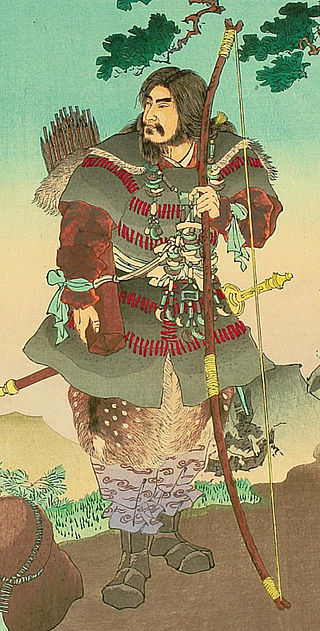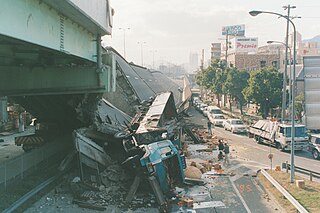Related Research Articles

Emperor Jimmu was the legendary first emperor of Japan according to the Nihon Shoki and Kojiki. His ascension is traditionally dated as 660 BC. In Japanese mythology, he was a descendant of the sun goddess Amaterasu, through her grandson Ninigi, as well as a descendant of the storm god Susanoo. He launched a military expedition from Hyūga near the Seto Inland Sea, captured Yamato, and established this as his center of power. In modern Japan, Emperor Jimmu's legendary accession is marked as National Foundation Day on February 11.

Emperor Keitai was the 26th legendary emperor of Japan, according to the traditional order of succession.

The Great Hanshin Earthquake occurred on January 17, 1995, at 05:46:53 JST in the southern part of Hyōgo Prefecture, Japan, including the region known as Hanshin. It measured 6.9 on the moment magnitude scale and had a maximum intensity of 7 on the JMA Seismic Intensity Scale. The tremors lasted for approximately 20 seconds. The focus of the earthquake was located 17 km beneath its epicenter, on the northern end of Awaji Island, 20 km away from the center of the city of Kobe.

The Nihon Shoki (日本書紀), sometimes translated as The Chronicles of Japan, is the second-oldest book of classical Japanese history. The book is also called the Nihongi. It is more elaborate and detailed than the Kojiki, the oldest, and has proven to be an important tool for historians and archaeologists as it includes the most complete extant historical record of ancient Japan. The Nihon Shoki was finished in 720 under the editorial supervision of Prince Toneri with the assistance of Ō no Yasumaro and presented to Empress Genshō. The book is also a reflection of Chinese influence on Japanese civilization. In Japan, the Sinicized court wanted written history that could be compared with the annals of the Chinese.

Dazaifu is a city located in Fukuoka Prefecture, Japan. As of 31 March 2024, the city had an estimated population of 71,505 in 33204 households, and a population density of 260 persons per km². The total area of the city is 29.60 km2 (11.43 sq mi).

Magatama are curved, comma-shaped beads that appeared in prehistoric Japan from the Final Jōmon period through the Kofun period, approximately 1000 BCE to the 6th century CE. The beads, also described as "jewels", were made of primitive stone and earthen materials in the early period, but by the end of the Kofun period were made almost exclusively of jade. Magatama originally served as decorative jewelry, but by the end of the Kofun period functioned as ceremonial and religious objects.

Hyūga Province was a province of Japan in the area of southeastern Kyūshū, corresponding to modern Miyazaki Prefecture Hyūga bordered on Ōsumi to the south, Higo to the west, and Bungo to the north. Its abbreviated form name was Kōshū (向州), although it was also called Nisshū (日州). In terms of the Gokishichidō system, Hyūga was one of the provinces of the Saikaidō circuit. Under the Engishiki classification system, Hyūga was ranked as one of the "middle countries" (中国) in terms of importance, and one of the "far countries" (遠国) in terms of distance from the capital.

The 2001 Gujarat earthquake, also known as the Bhuj earthquake, occurred on 26 January at 08:46 am IST. The epicentre was about 9 km south-southwest of the village of Chobari in Bhachau Taluka of Kutch (Kachchh) District of Gujarat, India.

Kashima Shrine is a Shinto shrine located in Kashima, Ibaraki in the northern Kantō region of Japan. It is dedicated to Takemikazuchi-no-Ōkami (武甕槌大神), one of the patron deities of martial arts. Various dōjō of kenjutsu and kendō often display a hanging scroll emblazoned with the name "Takemikazuchi-no-Ōkami". Prior to World War II, the shrine was ranked as one of the three most important imperial shrines Jingū (神宮) in the Shinto hierarchy, along with Ise Grand Shrine and Katori Shrine. During the New Year period, from the first to the third of January, Kashima Shrine is visited by over 600,000 people from all over Japan. It is the second most visited shrine in Ibaraki prefecture for new year pilgrims.

The Fukuoka earthquake, also known as the Fukuoka Prefecture West Sea Earthquake, struck Fukuoka Prefecture, Japan at 10:53 am JST on March 20, 2005, off the northwest coast of Fukuoka Prefecture, and lasted for approximately 1 minute. The Japan Meteorological Agency (JMA) measured it as peaking at a magnitude of 7.0 and a maximum seismic intesity of less than six, whereas the United States Geological Survey (USGS) reported a magnitude of 6.6. The quake occurred along a previously unknown fault in the Genkai Sea, North of Fukuoka city, and the residents of Genkai Island were forced to evacuate as houses collapsed and multiple landslides occurred in various places. Investigations subsequent to the earthquake determined that the new fault was most likely an extension of the known Kego fault that runs through the centre of the city.

The Jitō period is a chronological timeframe during the Asuka period of Japanese history. The Jitō period describes a span of years which were considered to have begun in the 1347th year of the imperial dynasty.
Kokki (国記), alternatively known as Kuni tsu Fumi meaning "National Record", is a Japanese historical text purported to have been written in 620 by Shōtoku Taishi and Soga no Umako. It is recorded in the Nihon Shoki, but there are no known extant copies. Assuming that it did in fact exist, it would predate both the Kojiki (712) and the Nihon Shoki (720).
The 869 Jōgan earthquake and its associated tsunami struck the area around Sendai in the northern part of Honshu on 9 July 869. The earthquake had an estimated magnitude of at least 8.6 on the moment magnitude scale, but may have been as high as 9.0, similar to the 2011 Tōhoku earthquake and tsunami. The tsunami caused widespread flooding of the Sendai plain. In 2001, researchers identified sand deposits in a trench more than 4.5 kilometres (2.8 mi) from the coast as coming from this tsunami.

The historiography of Japan is the study of methods and hypotheses formulated in the study and literature of the history of Japan.

The 2016 Kumamoto earthquakes were a series of earthquakes, including a magnitude 7.0 mainshock which struck at 01:25 JST on April 16, 2016 beneath Kumamoto City of Kumamoto Prefecture in Kyushu Region, Japan, at a depth of about 10 kilometres (6.2 mi), and a foreshock earthquake with a magnitude 6.2 at 21:26 JST (12:26 UTC) on April 14, 2016, at a depth of about 11 kilometres (6.8 mi).
The 684 Hakuho earthquake took place in Japan in 684, and is described in the history book Nihon Shoki from the 8th century. The earthquake took place on 26 November 684, in 13th year of the reign of Emperor Tenmu. It caused the under-sea inundation of approximately 10 km2 (3.9 sq mi) of rice fields.

The 1993 Kushiro–Oki earthquake was one of two large earthquake to strike the Japanese island of Hōkkaido within the same year. The earthquake with a magnitude of 7.6 Mw or 7.8 MJMA struck at 11:06 UTC or 08:06 pm JST on January 15 near the town of Ashoro. Shaking reached a maximum intensity of IX (Violent) on the Mercalli intensity scale, causing considerable damage, and was felt throughout the island, into northern Honshu, Sakhalin, and the Kuril Islands. As a result of the tremors, two people were killed and more than 600 were wounded.

Jimmu's Eastern Expedition refers to a series of legends in which Emperor Jimmu became the first emperor of Japan, after defeating Nagasunehiko, who had ruled the Nara Basin and its surrounding area, after leaving Hyuga Province.

The kōrokan were guest houses for foreign ambassadors, traveling monks, and merchants that existed in Japan from the Asuka period to the end of the Heian period. These guest houses existed in Fukuoka, Osaka and Kyoto. The word kōrokan (鴻臚館) was coined in the Heian period by using the first two characters from the Chinese name 鴻臚寺 for Han dynasty and Qi dynasty temples charged with the responsibility of hosting foreign dignitaries. Only the location of the kōrokan in Fukuoka is known with precision today; its ruins were discovered on the grounds of Maizuru Castle Park in 1987 and were designated a National Historic Site in 2004. The guest house in Fukuoka is called Tsukushi Kōrokan (筑紫の鴻臚館), after the name of Tsukushi Province, which is part of Fukuoka Prefecture today

Kōra-san kōgoshi (高良山神籠石) was an ancient castle (also known as a Korean-style fortresses in Japan located in the Mii neighborhood of the city of Kurume, Fukuoka Prefecture Japan. Its ruins have been protected as a National Historic Site since 1953, with the area under protection expanded in 1976 and again in 1989. It is also referred to as the Kōra-san castle ruins, as modern historians tend to discredit earlier theories that similar sites.
References
- ↑ Koji Minoura; Daisuke Sugawara; Tohru Yamanoi; Tsutomu Yamada (September 2015). "Aftereffects of Subduction-Zone Earthquakes: Potential Tsunami Hazards along the Japan Sea Coast". The Tohoku Journal of Experimental Medicine. 237 (2): 91–102. doi: 10.1620/tjem.237.91 . PMID 26399180.
- ↑ Tokuji Utsuno, Etsuzo Shima, Toshiaki Yoshii, Kenichiro Yamashina, Encyclopedia of Earthquakes, Asakura Publishing, 2010, ISBN 978-4254160536